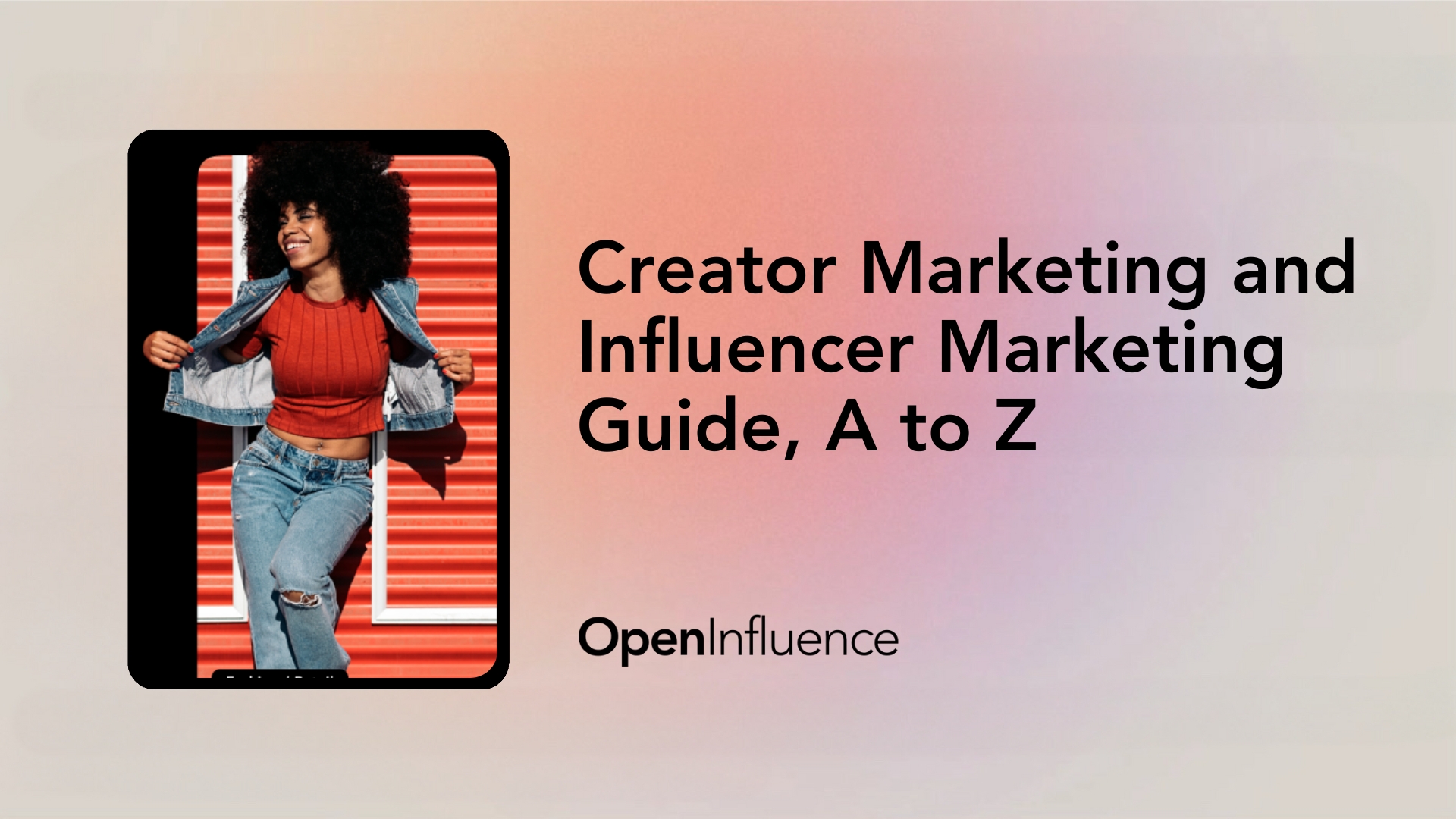A Glossary of Key Terms and Their Definitions
Creator marketing and influencer marketing have evolved from a niche component of marketing campaigns to a key focus of agencies and brands—a “nice-to-have” to a “must-have,” if you will.
This guide to influencer marketing from Open Influence provides explainers of key terminology used in the industry, as well as the differences and overlaps between creators and influencers.
Key Terms
Activations
Activations encompass any tasks sent by an agency or brand to a creator, including but not limited to negotiating terms, crafting a campaign brief, signing a contract, and launching a campaign.
Affiliate Marketing
Affiliate marketing enables creators to earn commissions on sales of products or services that they are promoting. Unique tracking links are used to attribute conversions to content from creators, and in some cases, discount codes are provided to creators by brands.
Always-On
An always-on creator marketing strategy helps build engagement with creators by tapping them year-round for content, events, and other marketing actions, rather than limiting the arrangement to individual campaigns.
Authenticity
When it comes to creators, authenticity means that the brands they work with and the content they produce align with the values they have shared with their audiences.
Brand Advocates/Brand Ambassadors
Brand advocates are social media users who organically support brands and recommend their products or services to family and friends due to their belief in the brands. This can be done via social media posts and/or word of mouth. Brand ambassadors go one step further, partnering with the brand and often reaching long-term arrangements to back the brand among their various communities.
Brand Authenticity
Brands can ensure the trust of their customer base by: remaining true to their stated mission; remaining true to their customers; helping customers remain true to themselves; and demonstrating responsibility and caring.
Brand Awareness
Brand awareness is the initial information that potential consumers learn about a brand, and creators can help shape that information by discussing the company and its products or services.
Calls to Action
Calls to action are the prompts brands and creators include in their campaigns’ content to help push potential customers to meet the goals of the campaign, with examples such as visiting a website/landing site, subscribing to a website/email newsletter, downloading an application and, naturally, “buy.”
Campaign Brief
Everything agencies, brands, and creators need to know about a campaign is included in the campaign brief, such as audience, objectives, key messaging, channels/platforms to be incorporated, and timing. Campaign briefs typically include an overview of the initiative, specific tasks (such as the number and types of posts, as well as the platforms they are earmarked for), payment details, guidance on language that should be used or avoided, other brand guidelines, and content usage rights.
Creative Strategy
Creative strategy is the combination of brand objectives, audience insights, and cultural trends that help determine the direction of a post or an entire campaign, and it influences stages of the process, including concept development, creator briefing, and tailoring content to each platform.
Creator Licensing
Formerly known as whitelisting, creator licensing occurs when brands run ads through the social media accounts of creators, so that potential customers see the content as authentic and coming from the creator, while the brand retains full control over the details.
Creator Listening
This process of tracking comments, mentions, reviews, and social media discussions related to a creator or creator marketplace helps agencies and brands gain a better understanding of audience sentiment, interest, and preferences.
Creator Management Platform
Creator management platforms are tools or suites of tools that help agencies and brands track all facets of their relationships and campaigns with creators and influencers.
Dark Posts
Dark posts refer to social media ads that don’t appear on the public profile of the creator.
Earned Media/Owned Media/Paid Media
- Earned media: Organically generated posts about a brand that do not originate from the brand or any of its representatives, including mentions in online articles or third-party write-ups, links shared on unaffiliated sites, reviews (including on platforms such as Yelp), mentions in traditional media (magazines or newspapers), and old-fashioned word of mouth.
- Owned media: Online properties that are owned by the brands, such as blogs, social media accounts, and websites.
- Paid media: Instances where brands pay to reach potential customers, such as through content promotion, paid engagements with creators, pay-per-click digital media ads, or social media ads.
Engagement Rate
Engagement rate is the metric most used by agencies and brands to gauge the effectiveness of their campaigns by analyzing how involved audiences are with the content.
Influencer Tiers
- Nano-influencer: Fewer than 10,000 followers
- Micro-influencer: 10,000 to 50,000
- Mid-tier influencer: 50,000 to 100,000
- Macro-influencer: 100,000 to 1 million
- Mega-influencer or celebrity: over 1 million
Key Performance Indicators
KPIs are metrics that a marketer uses to gauge the effectiveness of a campaign in meeting its goal or goals. Depending on the objective of the campaign, commonly used KPIs include app downloads, conversions, engagement rate, impressions, link clicks, and reach.
Live Shopping
A creator or celebrity promotes a product or service during a live video, and consumers can usually complete transactions via the platforms hosting the event.
Product Seeding
Creators receive free products from brands with the aim of featuring those products in their posts and driving sales. Some brands gift products with no expectations, while others reach arrangements with creators in advance.
Social Commerce
Social commerce is the sale of products or services directly to consumers via social media platforms, often using each respective platform’s interactive features. This includes platforms like TikTok Shop, Instagram Shop, and YouTube Shopping, which integrate product discovery, content engagement, and in-app checkout—allowing users to browse, interact, and purchase without leaving the platform.
Social Listening
Social listening is the process of analyzing conversations and trends around a brand or the entire industry, and the information gleaned from the process can help agencies and brands craft future campaigns and improve their messaging.
Social Proof
The concept of social proof is that if one person likes an item, another person will, too, driving purchase decisions.
Virtual Influencers
Virtual influencers are fictional characters spawned via technology such as artificial intelligence or computer-generated imagery that “post” to social platforms as if they were real creators.
Creators or Influencers?
Are they creators, influencers, or both? The two terms are often used interchangeably, although the latter has some negative connotations attached to it.
Generally speaking, creators tend to produce content with a focus on education, entertainment, or storytelling, while fare from influencers is more likely to be based on lifestyle, recommendations, and trends.
The audience for creators tends to be smaller in number and more niche, while influencers cast a more wide-ranging net, but there are exceptions on both sides.
Also, in the same way that all squares are rectangles but not all rectangles are squares, all influencers are creators but not all creators are influencers.
Creator Marketing or Influencer Marketing?
Expanding on the differences and similarities between creators and influencers detailed above, creator marketing usually refers to tapping into a creator’s connection with their niche audience and ability to provide high-quality, informative, and trustworthy content. Meanwhile, influencer marketing is more likely to encompass aspirational lifestyle content broadcast to a wider audience in order to raise awareness of a brand and its products or services.
Open Influence’s team stays on top of the latest trends and is here to help you maximize your creator campaigns. Open Influence is a leading global creator marketing agency dedicated to creating engaging campaigns.
FAQs
What is the difference between creator marketing and influencer marketing?
While influencer marketing traditionally focuses on leveraging a person’s reach and reputation to drive awareness or sales, creator marketing goes a step further by emphasizing the power of creativity and storytelling. Influencer marketing is about who delivers the message — the personality and their influence over an audience — while creator marketing is about what they create and how that content connects with people across platforms. In today’s landscape, creators aren’t just amplifying brand messages; they’re shaping them, producing original, authentic content that lives beyond a single post and drives long-term engagement.
Why has creator marketing become so important for brands today?
Audiences increasingly trust creators over traditional ads because their content feels personal and relatable. Brands use creators to build credibility, reach niche audiences, and inspire authentic engagement that drives conversions.
How do brands choose the right creators to work with?
Brands typically assess a creator’s audience demographics, engagement rates, and alignment with brand values. The best partnerships happen when the creator’s content naturally fits the brand’s message and audience interests.
What social platforms work best for creator marketing?
It depends on the audience and content type. TikTok drives discovery and viral reach, Instagram excels in visual storytelling, YouTube builds long-form trust, and emerging platforms like Twitch and Threads foster deep engagement.

